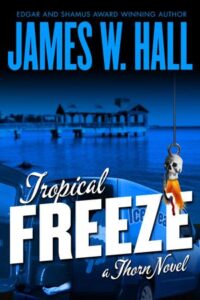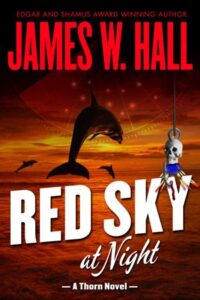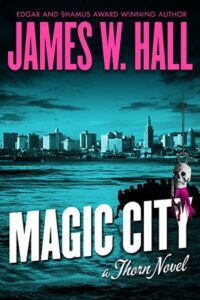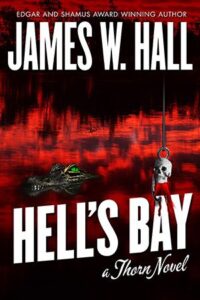Remembering one of my favorites.
I’d published two Thorn novels (Under Cover of Daylight and Tropical Freeze) with W.W. Norton in the late 80’s and I was ready to give Thorn a break. I frankly wasn’t sure if a recluse like Thorn was cut out to be a long-term series character. He wasn’t exactly anti-social, but he wasn’t all that receptive to new adventures like a private investigator would be or a cop or even a lawyer or journalist.
To force Thorn out of his cocoon, I’d already killed off two people very close to him, and I didn’t see how doing that again and again was sustainable.
About that same time my wife and I had an opportunity to spend a few months in Key West. A friend managed a rental property in Key West that happened to be available. “Hidden Beach” was owned by Seward Johnson of the Johnson and Johnson family. The house was divided into four units, two downstairs, two up. Evelyn and I got one of the lower units that was normally rented to John Malcolm Brinnin, a poet and critic who spent the summers in cooler climes.

Over the years the house had been the temporary home for numerous novelists, poets, publishers and other ne’er do wells, including Tom McGuane, Jimmy Buffet, Jim Harrison and a host of others. So it had an excellent literary vibe. Plus it was perfectly located on the waterfront between The Reach and Louie’s Backyard. In other words, it was an ideal place to spend a few months relaxing, drinking margaritas, fishing, swimming, and engaging in other indulgent activities.
Like writing Bones of Coral.

We did manage to take our 20 foot Mako out fishing now and then and out to one of the nearby reefs for some snorkeling. And I spent an hour or so every day learning to windsurf. So it wasn’t all work.
I can’t recall each chronological step of the writing process (I mean this was over 30 years ago), but I’ll list a few of the ingredients I started with.
The bad guy: I’ve always tried to find bad guys who for one reason or another scared me. One of the scariest traits I can think of is a total lack of empathy. Someone who simply doesn’t understand or care about other people’s pain can be capable of extreme cruelties that average people find horrendous because they do have empathy.
Evil comes in many forms, of course, and those creatures who actually find pleasure in inflicting pain on others are certainly frightening. Serial killers fall into this general category. But someone who is missing the empathy gene is somehow even scarier to me because their violence can seem innocent. When they hurt someone they may not fully grasp the damage they’ve done because they don’t know what pain is. They don’t enjoy inflicting pain as sadists do; they’re simply neutral.
This is how Dougie Barnes was born. He’s a man who literally has no pain threshold. So his ability to understand the pain of others is severely limited. Dougie may or may not be “on the spectrum.” If he is, it’s a pretty unique spectrum.
Multiple sclerosis: (as this link shows) Key West had a very high incidence of MS. It was mysterious connection that might have had some connection with the large trash dump near downtown Key West, and very near the Key West hospital where numerous nurses had been diagnosed with MS.

In the early stages of researching the book, after deciding I wanted to know about the connection between Key West and multiple sclerosis, I spent an evening with a group of newly diagnosed MS folks in Miami. They were being briefed on the nature of the disease and its possible progression and the doctors who were running the evening’s program answered their questions.
I had only a passing knowledge about MS and had simply chosen it as a possible subject because of the mysterious connection it had to Key West. But that evening was a watershed moment for me. I was deeply moved by the stories I heard, and by the anxiety and in some cases shock that was evident in the room that night.
With a new level of resolve that this was a subject that truly mattered, I spent hours in the bowels of the university library digging through documents to find anything else that might play a role in the Key West/MS subject. Finally, I stumbled on a report from a congressional sub-committee in which Key West figured prominently.
The report described a series of U.S. Army aerial spraying tests that occurred in several U.S. locations in the fifties. The purpose of those tests was to better understand how vulnerable various cities were to a bioweapon attack. That report (which this Wikipedia page link describes) has a small footnote about the ethics of testing unsuspecting civilian populations. The morality of that testing, together with the high incidence of MS in Key West, formed the basis of my story, Bones of Coral.
That ethical issue was what attracted Hugh Hudson (Academy Award director of Chariots of Fire) to sign on the MGM project to bring Bones of Coral to the screen. The history of that project is the subject of another blog post.
That summer in Key West was also marked by a close encounter with crime, Keys style. One night while we slept, our great dane woke us with a loud bark. We shushed her and went back to sleep. She was trying to alert us to a burglar who’d broken into our ground level apartment (we later learned that this apartment was a frequent target for burglars). The next morning I went outside to check the weather and found that all the ballyhoo in the ice chest that we’d used for bait the day before had been stolen. A couple of fishing rods were gone as well and some other fishing supplies. A classic Key West caper. My watch was still sitting on the dresser by the sliding glass door that the burglar had entered, and my wallet was untouched. The guy had just wanted to go fishing.
A few words about the title.
Spanish settlers originally called Key West Cayo Hueso, which translates to bone island, referring to the bones of the Calusa Indians who had once lived in the Florida Keys. English speakers mistook Cayo Hueso, thinking it sounded like Key West and the name stuck.
I put that together with a little Shakespeare and came up with the title.
(from The Tempest)
Full fathom five thy father lies;
Of his bones are coral made;
Those are pearls that were his eyes:
Nothing of him that doth fade,
But doth suffer a sea-change
Into something rich and strange.
Below are a few of the covers for the book.
I’ve always liked the original one that Sonny Mehta (my editor at Knopf) presented to me in Coral Gables one sunny afternoon. The slightly deranged looking parrot actually plays a small part in the novel.

The next one is from the paperback version. And the last one is from British edition.



!!! NOTICE: ON DECEMBER 19TH THE ebook of BONES OF CORAL WILL BE FREE ON AMAZON FOR 3 DAYS.























